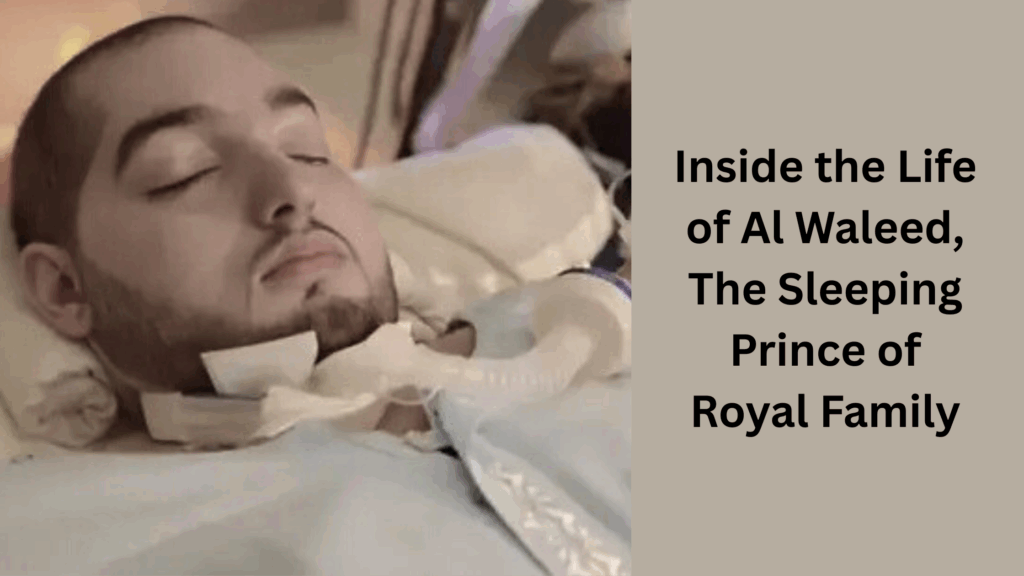
Inside the Saudi royal family a distinctive narrative exists which reveals the story of a family member resting in permanent unconsciousness because of his strong devotion to love and his unwavering faith and patience. Prince Al Waleed bin Khaled bin Talal Al Saud the Sleeping Prince among the Saudi royals entered a permanent coma after a fatal incident occurred in 2005. The symbolic life of this individual now inspires hope and endurance in millions who look upon his story across the globe.
Royal Lineage and Early Life of Al Waleed, The Sleeping Prince
Born into a preeminently powerful royal dynasty of the Middle East the Saud family has blessed Al Waleed bin Khaled bin Talal Al Saud with his birth. The son Prince Khaled bin Talal Al Saud grew up with his religious and philanthropic father who carries prominence as a Saudi royal. Meanwhile his uncle Prince Alwaleed bin Talal Al Saud stands as the wealthiest Arab person known worldwide for his business achievements.
Prince Al Waleed experienced a sheltered beginning in life where he immersed in both financial wealth and social advantage along with abundant possibilities from the moment of his birth. His family background prioritizes academic pursuit along with leadership qualities and preserves religious beliefs. Royalty expected him to preserve the inherited heritage of his ancestors which brought great promise to his future.
The Accident That Changed Everything
In 2005, tragedy struck. Prince Al Waleed experienced a severe high-speed car crash as a 18-year-old when he attended school in London. His head received serious damage during this incident thus placing him in a prolonged coma. His coma condition remains permanent since the day of the accident.
When doctors first assessed the Prince they predicted that he would survive only infrequently or not at all. Life support was considered for many patients in his situation but his family together with his father decided to keep fighting for his survival. Heritage Islamic beliefs alongside his fatherly devotion guided Prince Khaled to maintain treatment since he believed his son one day would wake up.
A Life in Stillness: Al Waleed, The Sleeping Prince
After eighteen years Prince Al Waleed has existed in a medically defined minimally conscious state which doctors label a coma that’s why also knwon as Sleeping prince. The medical state which afflicts him does not separate him from others. A caring atmosphere permeates through the hospital room as people provide continuous prayer and care for the patient. Medical personnel alongside religious scholars together with his family members spend their time continuously caring for him. The sound of Qur’anic recitations plays in low volume while medical staff make periodic observations of minor movements and eye movements which indicate signs of bodily response.
The Prince expressed movement by shifting his hand during an online video release when his father delivered remarks to him. The public witnessed a life sign while the video about this moment spread across the internet driving fresh hope to all those who had followed his story throughout the years. The citizens of the Arab world and people from different continents expressed their support through prayers and blessings after witnessing a brief movement from Kubayli. These sentiments of hope emerged because of the simple but impactful sign of his survival.
His Father: A Portrait of Unwavering Love
The public image of Prince Al Waleed remains closely linked to the story of his father who is Prince Khaled bin Talal. Prince Khaled maintains a deeply faith-based worldview which established him as a national representation of fatherly devotion together with spiritual strength. Throughout public interviews and religious talks he defends his medical decision to maintain life support in response to doctor discretion to let go of support.
According to him Al Waleed functions as more than just his son because his father uses the critical situation to demonstrate religious faith. Through his social media he creates posts which persuade others to maintain spiritual faith through prayers for his son during this difficult period.
Public Interest and National Symbolism
The tale about the Sleeping Prince spread across Arab territory as people started to recognize it in their communities. Multiple Saudi citizens along with other international users post about Prince Al Waleed through videos and messages which highlight their respect for how his family endured as they extend their supportive thoughts.
His case now transcends mere medical coma facts because he symbolizes three key elements: hope and family devotion together with the wonders of destiny. Through his silent presence the Prince has triggered public dialogues about existence value and medical ethics and human connection longevity.
Read More: Meet Simon Paisley Day , Actor Who Played General Dyer in Kesari 2
A Story That Transcends Words
Against the dominant forces of excess noise and relentless speed and sensationalism we find in our modern world the story of Prince Al Waleed bin Khaled emphasizes peace. The calm bed rest contains an inspiring message which teaches us about life’s shortness and the meaningful aspects of faith and familial bonds.
The king’s legacy remains unmarked by formal pronouncements or official announcements because it slowly grows through his daily hospital experience where loved ones keep him close. The monument stands through the interminable prayers of his father as nurses extend gentle medical care and through millions who harbor secret wishes for the Prince to regain consciousness.
Conclusion: A Prince of the Heart
The world has listened eloquently to the words of the silent Prince Al Waleed bin Khaled bin Talal. Through his silent existence he demonstrates the strength behind hope together with his belief that light remains visible even within dark times.
Many individuals identify Al Waleed as The Sleeping Prince. To those who follow his life story he represents more than a sleeping man because he becomes an emblem of everlasting love and demonstrates faith and reminds us that our deepest transformations occur within ourselves.






